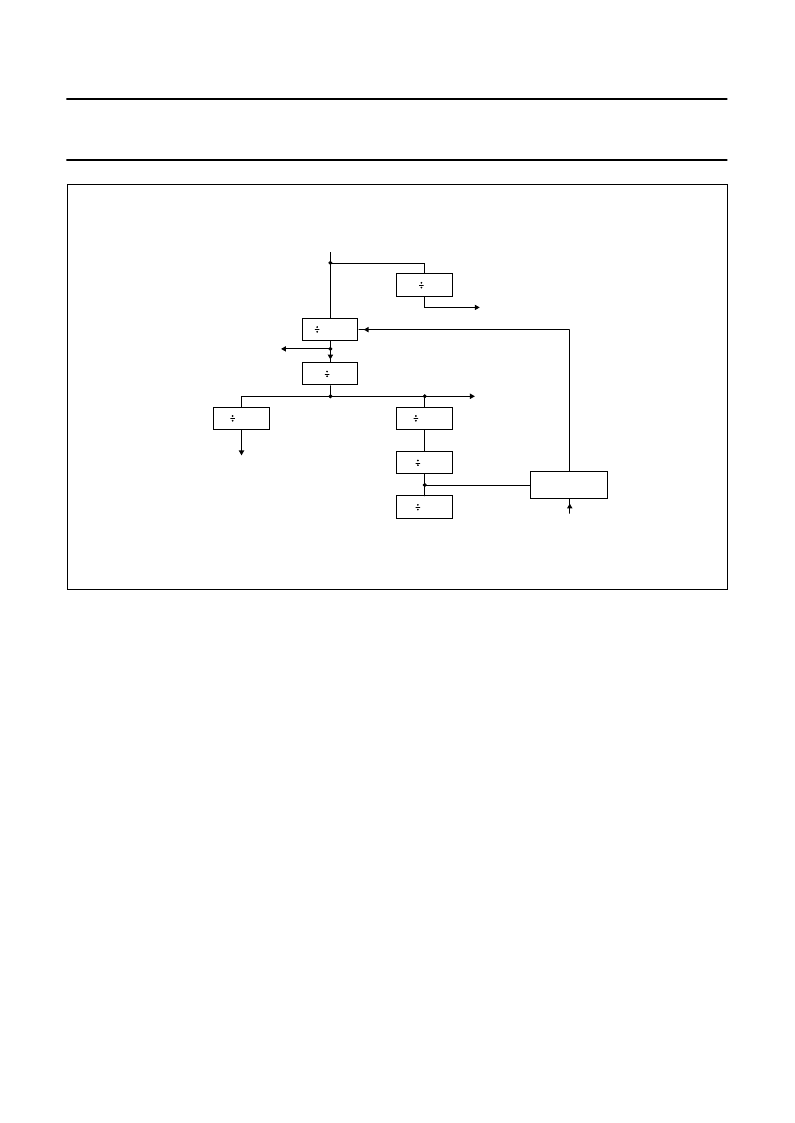- 您現(xiàn)在的位置:買賣IC網(wǎng) > PDF目錄382380 > PCD5042 (NXP Semiconductors N.V.) DECT burst mode controller PDF資料下載
參數(shù)資料
| 型號: | PCD5042 |
| 廠商: | NXP Semiconductors N.V. |
| 英文描述: | DECT burst mode controller |
| 中文描述: | 無繩突發(fā)模式控制器 |
| 文件頁數(shù): | 10/28頁 |
| 文件大小: | 134K |
| 代理商: | PCD5042 |
第1頁第2頁第3頁第4頁第5頁第6頁第7頁第8頁第9頁當前第10頁第11頁第12頁第13頁第14頁第15頁第16頁第17頁第18頁第19頁第20頁第21頁第22頁第23頁第24頁第25頁第26頁第27頁第28頁

1996 Oct 31
10
Philips Semiconductors
Objective specification
DECT burst mode controller
PCD5042
Fig.4 Internal clocking scheme of the PCD5042.
handbook, full pagewidth
MBH708
480
bit counter
3.456 MHz system
clock for ADPCM codec
24
slot counter
100 Hz
frame sync
1152 kHz
system/bit clock
clock corrections in this level
unless disabled PCD5041's mode register
COMPARATOR
'SYNC' event
FSx signals
(8 kHz)
16
slot counter
2
144
3
4 (
±
1)
13.824 MHz system clock
6.912 MHz system clock
6.4
Speech interface
The speech interface block performs the following
functions:
Connection to a 1152 kbits/s interface in a handset and
a simple base station in the so called ‘12 slot mode’
Connection to a n x 64 kbits/s interface in base stations
in the so called ‘32 slot mode’
Autonomous storing/fetching of ADPCM speech data
in/from the PCD5042’s common data memory, using
internal addressing logic
Muting of speech data
Local call.
6.4.1
12-
SLOT MODE
The 12-slot mode is selected if up to 4 ADPCM CODECs
are connected to the PCD5042, where the PCD5042 is the
master of these CODECs. In a handset, or in a simple
base stations which is connected with up to 4 analog lines
to the public network, the PCD5042 is master of the
CODECs. Each CODEC is connected with a separate
framing reference signal (FS1 to FS4) to the PCD5042. In
the QFP64 package, 2 framing signals FS1 and FS2 are
available, whereas in the LQFP80 package 4 framing
signals can be used (FS1 to FS4). When more CODECs
are to be connected, the FS5 to FS12 signals have to be
generated externally. When using the framing signals
FS1 to FS4, no interface logic is required when using the
PCD5032 ADPCM CODEC.
A speech-slot control table is used to determine where to
store/fetch speech data for transmission and reception.
The hardware speech-interface is capable of addressing
the right speech buffer for the relevant speech slot, and will
maintain a counter carrying the offset to the correct
stored/fetched address.
6.4.2
32-
SLOT MODE
The 32-slot mode is used to connect the PCD5042 to a
digital interface with a data rate of n
×
64 kbits/s; where
n = 1 to 32 is the number of speech slots. This equates to
data rates from 64 kbits/s to 2048 kbits/s.
Up to 12 of the 32 speech slots can be used
simultaneously. The same kind of speech-slot control table
used in the 12-slot mode is used for the 32-slot mode.
6.4.3
M
UTING
Due to various reasons the quality of the incoming speech
data may be degraded significantly. By muting the speech
相關(guān)PDF資料 |
PDF描述 |
|---|---|
| PCD5043 | DECT burst mode controller |
| PCD5043H | DECT burst mode controller |
| PCD5091HZ | DECT baseband controller |
| PCD5091 | DECT baseband controller |
| PCD5091H | DECT baseband controller |
相關(guān)代理商/技術(shù)參數(shù) |
參數(shù)描述 |
|---|---|
| PCD5042H | 制造商:PHILIPS 制造商全稱:NXP Semiconductors 功能描述:DECT burst mode controller |
| PCD5042HZ | 制造商:PHILIPS 制造商全稱:NXP Semiconductors 功能描述:DECT burst mode controller |
| PCD5043 | 制造商:PHILIPS 制造商全稱:NXP Semiconductors 功能描述:DECT burst mode controller |
| PCD5043H | 制造商:PHILIPS 制造商全稱:NXP Semiconductors 功能描述:DECT burst mode controller |
| PCD5071 | 制造商:未知廠家 制造商全稱:未知廠家 功能描述:MODEM |
發(fā)布緊急采購,3分鐘左右您將得到回復(fù)。